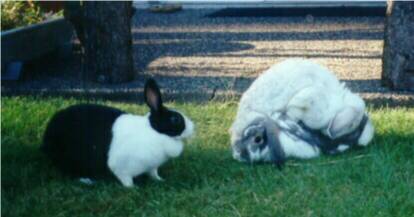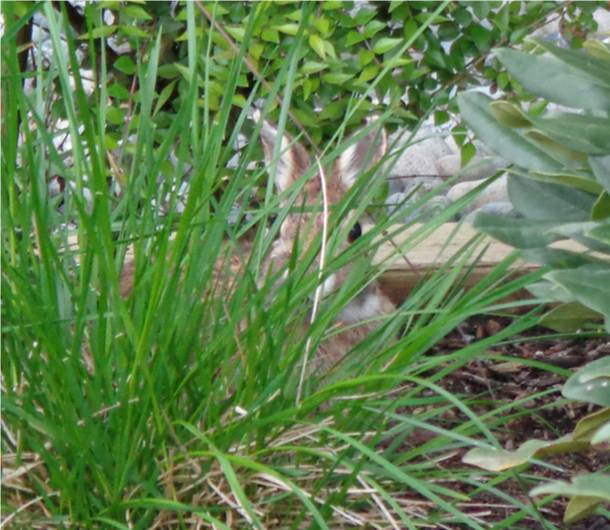Rabbits, Cottontails, and Hares
Rabbit Advocacy often receives calls from people concerned about rabbits they see in the park, by the road, on hospital grounds, or in industrial areas. These rabbits are most likely offspring of somebody’s dumped "pet." It's very common for people to bring their domestic rabbit to an existing colony or anywhere else that's easy and convenient. Sometimes the rabbit's already pregnant. Unless the animal has been put out recently, it's not that easy to "rescue" one, should you be so inclined. Being a prey animal, they are constantly alert, with a keen sense of smell and hearing, and will dart for cover if you get too close. First generation baby rabbits learn survival skills very early and are considered feral. Keep in mind that shelters, rescue groups, and such are filled beyond capacity with unwanted bunnies, and finding good, permanent homes is rather challenging. Some stay in their foster home for a year or more, and others never leave. There are several rabbit sanctuaries in BC, but they are limited in the numbers that they can accept, and not all are candidates for that sort of life.
If you come across an injured rabbit, call your local humane society or a vet. For advice on finding a nest of bunnies visit http://www.rabbit.org/faq/sections/orphan.html There have been several large scale rescue and relocation efforts of rabbits, such as the one Best Friends undertook in Reno, 2006, and another that saw Washington's House Rabbit Society safely relocate a population in Redmond. Currently, The Responsible Animal Care Society (TRACS) is spearheading an effort to save the Kelowna bunnies. (2008)
There are many species of rabbits, along with cottontails, pikas, and hares that make up the Order: Lagomorpha (lagomorphs)
- Family: Leporidae (rabbits & hares; jackrabbits are hares)
- Genus: Oryctolagus
- Species: Oryctolagus cuniculus - European rabbit, also called an Old World or domestic. Our companion rabbits of present are descended from the wild European rabbit, cross-bred by rabbit "fanciers" and others, creating the numerous breeds and variations thereof today. Many of these become abandoned, unsterilized, into the environment by their human.
- Cottontail
- Family: Leporidae
- Genus: Sylvilagus
- Hares
- Family: Leporidae
- Genus: Lepus
Lagomorphs are an order of herbivorous mammals with a prolific reproductive rate. For the most part, hares and rabbits differ in appearance, with the larger grey-brown hare appearing more streamlined and wiry, with bigger and stronger back legs and feet. They tend to jump, rather than run. Another characteristic is their long, straight-up ears that are generally longer than their head. There are assorted varieties of jackrabbits among the North American hares. Many, along with the Snowshoe Hare, change colour during the winter season, as a form of camouflage to blend in with the snow, whereas rabbits keep the same coat colour year round.
Rabbits are altricial, meaning that the kits are born blind, hairless, and helpless, while hares are precocial, the leverets born with fur and vision (open-eyed) and able to fend for themselves fairly quickly. This is undoubtedly related to the fact that hares give birth in shallow depressions or nests above ground, while rabbits, except for the cottontail genus, give birth in underground burrows or warrens. Most rabbits also live in these warrens as adults in groups/herds, while hares and cottontail rabbits live singly or in pairs in above-ground nests.
While
rabbits dig burrows and inhabit brush,
scrub, or wooded areas, hares don't, living instead in the open grassland and
grassy depressions called forms.
The European or domestic rabbit was introduced to BC by settlers. They are listed in the Environment and Wildlife Regulation as an alien, invasive species when abandoned into the environment. Increasingly, they are regarded as “pests” or "nuisance fauna" in areas throughout the province, and are given no protection under Section C of the Wildlife Act. Please write the Ministry of Environment and request that rabbits and other animals relegated to Section C be given value and protection.
Please contact us for any questions or concerns you may have on any rabbit matter.
May 13, 2017 Since moving to Tsawwassen in 2016, we have seen a number of Eastern Cottontails in the area. A young Eastern Cottontail (Sylvilagus floridanus) is sitting in our backyard this evening.
 The
Eastern Cottontail has expanded its range into the Lower Mainland from
introduced populations in Washington State (Cowan and Guiget 1965). They are
seen throughout the lower Fraser Valley along dykes and in agricultural areas
from Chilliwack to Tsawwassen. Sadly, like all other species, we are taking away
their habitat to accommodate the ever-growing human population.
The
Eastern Cottontail has expanded its range into the Lower Mainland from
introduced populations in Washington State (Cowan and Guiget 1965). They are
seen throughout the lower Fraser Valley along dykes and in agricultural areas
from Chilliwack to Tsawwassen. Sadly, like all other species, we are taking away
their habitat to accommodate the ever-growing human population.
In 1964, they were introduced to Vancouver Island and can still be spotted throughout the eastern Island from Victoria to Campbell River. They have 2-5 litters per year with up to 8 kits per litter and can begin to reproduce between 2-3 months. On average, they live about 15 months.
Read more: Eastern Cottontails at risk of disappearing; L. a. washingtonii
U.S. agrees to consider protections for pikas after lawsuit filed
Visit our Nature - Human Impact Page